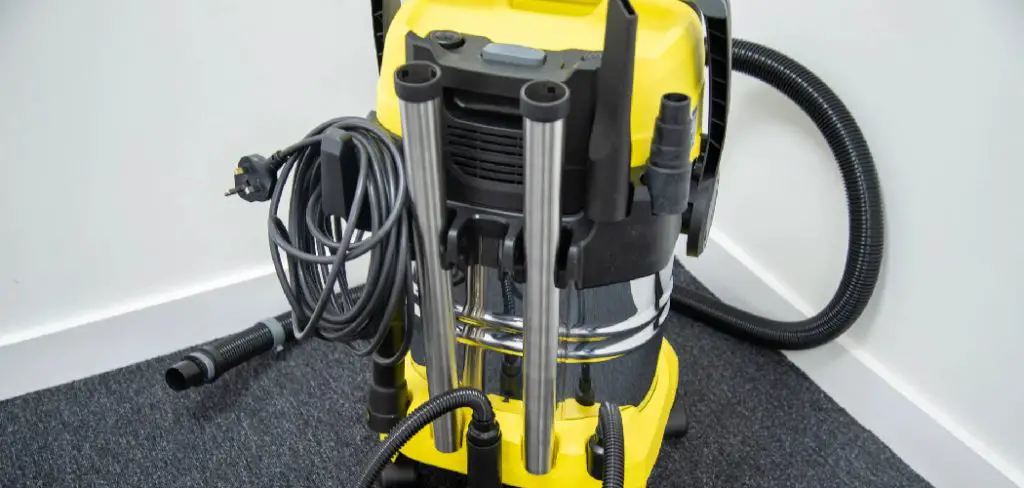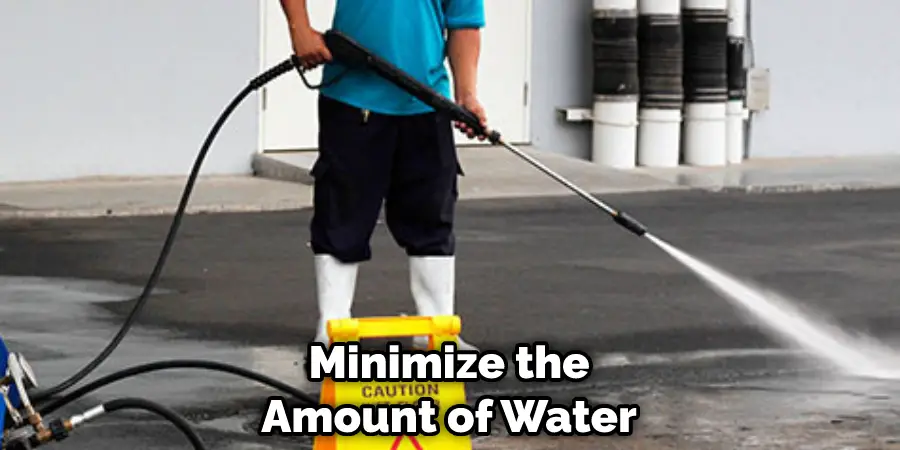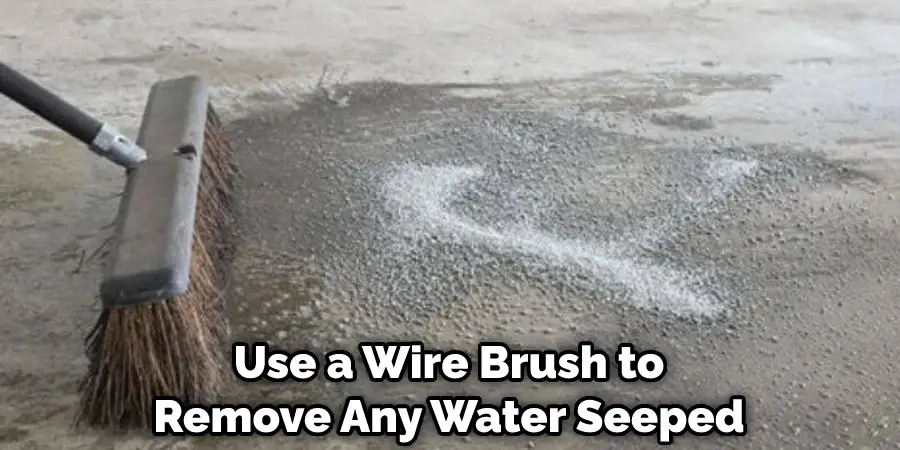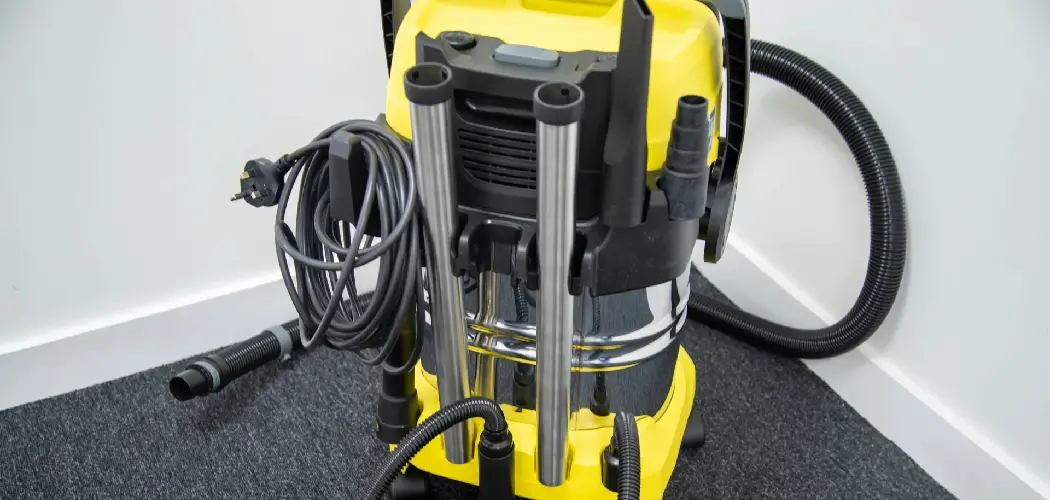You can use a few simple tricks to ensure your garage floor comes clean without any water damage. First, be sure to use a pressure washer with adjustable pressure settings. Start with the pressure setting on low and gradually increase it until you find the right balance of power and safety.

Next, hold the nozzle of the pressure washer close to the ground and keep it moving as you work. Finally, rinse the area with plain water to remove any soap residue after you finish washing. In this blog post, You will learn in detail how to pressure wash garage floor without getting walls wet.
Summary: Pressure washing your garage floor can be tricky, as you need to make sure the walls don’t get wet. To pressure wash without getting the walls wet, first use tape and plastic sheeting to cover the walls and other surfaces you don’t want water to reach. Then, use a fan nozzle on your pressure washer instead of a regular one, as the fan nozzle will disperse water at a lower rate and help avoid spraying your walls. Once you have finished pressure washing the floor, use cord covers or other materials to hide the wires from your garage door opener.
Step-by-Step Processes for How to Pressure Wash Garage Floor Without Getting Walls Wet
Step 1: Gather Necessary Supplies and Equipment
To pressure wash your garage floor without getting the walls wet, you will need the following supplies and equipment:
- Pressure washer
- Extension wand (optional)
- Protective eyewear and gloves
- Waterproof boots or shoes
- Broom or leaf blower
- Degreaser or cleaning solution suitable for concrete
- Plastic sheeting or tarps
- Painter’s tape or duct tape
Step 2: Prepare the Garage Floor
Before pressure washing, clear the garage floor of any vehicles, tools, and other items. Sweep the floor with a broom or use a leaf blower to remove any loose debris, dirt, and dust. This will make the pressure washing process more efficient and minimize the amount of dirt splatter.
Step 3: Protect the Walls and Surrounding Areas
To prevent water from getting on the walls and surrounding areas, cover them with plastic sheeting or tarps. Measure and cut the sheeting or tarps to fit the walls and any built-in shelving or cabinetry. Use painter’s tape or duct tape to secure the coverings in place, ensuring that there are no gaps where water can seep through.
Step 4: Mix the Cleaning Solution
Follow the manufacturer’s instructions to mix the appropriate amount of degreaser or concrete cleaning solution with water in a bucket or the pressure washer’s detergent reservoir. Ensure that the cleaning solution is suitable for use with a pressure washer and safe for your garage floor’s surface.
Step 5: Set Up the Pressure Washer
Assemble and connect the pressure washer according to the manufacturer’s instructions. Attach the extension wand, if using, to help direct the water flow more accurately and minimize splatter. Connect the pressure washer to a water source and the detergent reservoir, if applicable. Put on protective eyewear, gloves, and waterproof footwear to protect yourself from the high-pressure water and cleaning solution.
Step 6: Apply the Cleaning Solution
Turn on the pressure washer and set it to a low-pressure setting. Apply the cleaning solution to the garage floor, starting at the back of the garage and working your way towards the entrance. Work in small, manageable sections to ensure even coverage and prevent the solution from drying on the surface.
Step 7: Allow the Cleaning Solution to Sit
After applying the cleaning solution to the entire garage floor, allow it to sit for the recommended amount of time specified by the manufacturer. This will enable the solution to penetrate the concrete and break up any dirt, grease, or stains.
Step 8: Adjust the Pressure Washer Settings
Before rinsing the garage floor, adjust the pressure washer settings to the appropriate level for cleaning concrete. Consult your pressure washer’s owner’s manual for specific recommendations, as excessive pressure can damage the surface.
Step 9: Rinse the Garage Floor
Using the pressure washer, rinse the garage floor, starting at the back of the garage and working your way towards the entrance. Hold the wand at a slight angle, directing the water flow towards the floor and away from the walls. Move the wand in a sweeping motion to disperse the water evenly and prevent pooling.
Step 10: Control the Water Flow
As you pressure wash the garage floor, be mindful of the water flow and adjust your technique as needed to minimize splatter. Use the extension wand to help direct the water more accurately, and maintain a steady, consistent distance between the wand and the floor to prevent water from spraying onto the walls.
Step 11: Inspect the Garage Floor
After rinsing the entire garage floor, turn off the pressure washer and inspect the surface for any remaining dirt, grease, or stains. If necessary, reapply the cleaning solution to any problem areas, allow it to sit, and rinse again with the pressure washer. Repeat this process until you are satisfied with the cleanliness of the garage floor.
Step 12: Remove Standing Water
Once the garage floor is clean, use a large foam squeegee or a floor broom to push any remaining standing water towards the entrance or a nearby floor drain. This will help prevent water from pooling on the floor and minimize the potential for water damage or mold growth.
Step 13: Allow the Garage Floor to Dry
Leave the garage door open to allow the floor to air dry completely. Depending on the size of the garage and the weather conditions, this may take several hours or up to a full day. Do not replace any items or vehicles in the garage until the floor is completely dry to prevent damage or slipping hazards.
Step 14: Remove Protective Coverings
Once the garage floor is dry, carefully remove the plastic sheeting or tarps from the walls and surrounding areas. Dispose of the coverings, or clean and store them for future use. Inspect the walls and any built-in features for signs of moisture, wiping them dry with a clean towel if necessary.
Step 15: Return Items to the Garage
When the garage floor is dry and the walls are free of moisture, return any vehicles, tools, and other items to their original locations in the garage. Take this opportunity to organize your garage and eliminate any clutter or unnecessary items.
Step 16: Clean and Store the Pressure Washer
After completing the pressure washing process, clean the pressure washer according to the manufacturer’s instructions. Remove any remaining cleaning solution, rinse the detergent reservoir, and clean the wand and nozzle attachments. Allow the pressure washer to dry completely before storing it to prevent damage and ensure its longevity.
Step 17: Maintain a Clean Garage Floor
To keep your garage floor clean and minimize the need for frequent pressure washing, sweep or use a leaf blower regularly to remove dirt and debris. Clean up any spills or stains immediately to prevent them from penetrating the concrete and becoming more difficult to remove. Consider applying a concrete sealer or garage floor coating to protect the surface and make cleaning easier.
By following these steps and using proper pressure washing techniques, you can effectively clean your garage floor without getting the walls wet. This will not only improve the appearance of your garage but also help prevent damage to the walls and surrounding areas. Regular garage floor maintenance will keep your space clean and organized, making it a more enjoyable and functional part of your home.
10 Tips for How to Pressure Wash Garage Floor Without Getting Walls Wet
- Always wear protective gear when pressure washing, including goggles or glasses, gloves, earplugs, or other hearing protection.
- Inspect your pressure washer before each use to ensure that it is in good working condition and that all hoses are properly connected.
- Fill the pressure washer’s tank with the appropriate type of cleaning solution according to the manufacturer’s instructions.
- Set up your pressure washer so that the spray nozzle points away from you and any bystanders before starting the machine.
- Slowly turn on the water supply and allow the pressure washer to build up to full pressure before washing.
- Hold the spray nozzle at a distance of 12 to 24 inches from the surface you are cleaning and move it in a steady back-and-forth motion.
- Avoid using too much pressure or keeping the spray nozzle in one spot for too long, as this could damage the surface or cause accidents.
- After you finish pressure washing, turn off the machine and release any remaining pressure in the hose before disconnecting it.
- Always clean up any leftover cleaning solutions or debris after pressure washing to avoid slips and falls.
- Follow all manufacturer’s instructions when using a pressure washer to ensure optimal performance and safety.
How Do You Prevent Water From Damaging Your Garage Walls When Pressure Washing the Floor?
If you have a garage with a concrete floor, you may wonder how to pressure wash the floor without damaging the walls. Water can seep into cracks and crevices in concrete, causing serious damage to your garage over time. Fortunately, you can do a few things to prevent this from happening. Here are a few tips on how to pressure wash your garage floor without damaging the walls:
- Use a Wide-angle Nozzle: This will help distribute the water evenly over the floor’s surface and minimize the amount of water that comes into contact with the walls.

- Start at the Farthest Point From the Door: This will ensure that you don’t accidentally pressure wash the door while you’re trying to clean the floor.
- Move the Wand in a Side-to-side Motion: This will help evenly distribute the water and minimize the time that any area is exposed to high pressure.
- Use a Lower Pressure Setting: This will help to prevent the water from seeping into cracks and crevices in the concrete.
By following these tips, you can pressure wash your garage floor without damaging the walls.
Is There a Special Attachment or Nozzle You Can Use to Pressure Wash Your Garage Floor Without Getting the Walls Wet?
You can do a few things to pressure wash your garage floor without getting the walls wet. One is to use a rotary nozzle, which will spin the water around in a circle and create a powerful stream that can reach those tough, caked-on stains.

Another option is to use a low-pressure nozzle, which will help reduce the amount of dispersed water. Finally, you can also try using a smaller attachment, such as a wand, to get into those tight spaces and prevent the water from spreading too far. Following these tips, you can finally clean your garage floor without worrying about damaging the walls.
How Often Should You Pressure Wash Your Garage Floor?
If you use your garage regularly, it’s a good idea to pressure wash the floor at least once a season. This will help remove any dirt, grime, or oil built up over time. If you have a very dirty garage floor, you may need to pressure wash it more frequently.
You’ll need to use a wide-angle nozzle to pressure wash your garage floor without getting the walls wet. Start by pressure washing the perimeter of the garage floor, then move on to washing the center area.
Be sure to keep the nozzle moving, so you don’t oversaturate any area. Once you’re finished pressure washing, allow the floor to dry completely before driving or walking on it.
You Can Check It Out Get a Hummingbird Out of My Garage
What Should You Do if You Accidentally Get Water on Your Garage Walls While Pressure Washing the Floor?
You can do a few things to fix the situation:
- If the wall is painted, you’ll want to ensure that the paint is not blistering or peeling. If it is, you’ll need to repaint the wall.
- If the wall is not painted, you can try using a putty knife or other tool to scrape off any excess water.
- If the wall is made of brick or stone, you may use a wire brush to remove any water seeped into the pores.
- If none of the above options work, you can always try repainting the wall.
- Remember, it’s always better to be safe than sorry when it comes to pressure washing your garage floor.

Is It Necessary to Contact With Any Professional to Pressure Wash the Garage Floor Without Getting Walls Wet?
Many people think that they need to contact a professional to pressure wash their garage floor without getting the walls wet. However, this is unnecessary if you have the right tools and equipment.
The first thing you need to do is to ensure that the area you will be washing is clear of any debris or objects that could get in the way. Next, you must attach the pressure washer hose to the spigot and turn on the water. Once the water runs, you can start pressure washing the floor.
Be sure to move the wand in a back-and-forth motion to evenly distribute the water over the surface. When you are finished, be sure to turn off the water and disconnect the hose from the spigot. You may also want to rinse off any remaining soap with a garden hose before allowing the area to dry completely.
How Much Will Pressure Wash Garage Floor Cost Without Getting Walls Wet?
If you’re considering renting a pressure washer, expect to pay around $40 daily. For a DIY project, you’ll need to purchase a pressure washer, which starts at around $100.
You’ll also need to buy some supplies, such as a hose and nozzle attachment, which can cost around $30. Depending on the size of your garage, you may need to buy additional supplies, such as detergent and extension cords. In total, expect to spend around $200-$300 on a DIY pressure washing project.
By comparison, hiring a professional to pressure wash your garage floor will cost around $300-$400. Therefore, renting a pressure washer and doing the job yourself is generally more cost-effective. However, it’s worth paying for professional assistance if you don’t have the time or the skills to do it yourself.
You Can Check It Out Clean Polyurea Garage Floors
Conclusion
Overall, it is beneficial to pressure wash your garage floor without getting the walls wet. This helps to avoid any potential damage that could be caused by water seepage. It also keeps the area around your garage cleaner more presentable. However, there are a few things to keep in mind when pressure washing your garage floor.
Make sure to use the correct settings on your pressure washer, and always use caution when operating the machine. With a little bit of care, you can easily pressure wash your garage floor without damaging any surrounding areas.
I hope this article has been beneficial for learning how to pressure wash garage floor without getting walls wet. Make Sure the precautionary measures are followed chronologically.

